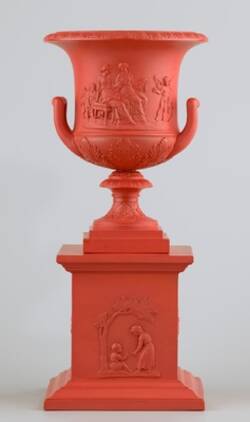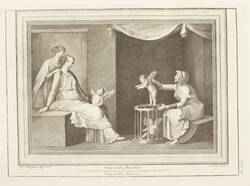Further Media


It is not the shape of the crater vase or the scene with the love gods facing the viewer that attract attention at first glance, but the reddish-brown painted material in which it is formed. It is known as terralite or siderolite. In an entry written in 1857 in the Mittheilungen auf dem Gebiet der Statistik, the following can be learned about this mass, which was widespread during the nineteenth century:
“Under these synonymous names, clay wares are produced in northern Bohemia, which differ from all other earthen wares in colour as well as in the varnish coating. The rather white, highly plastic clay from Preschkau near Bilin, which is also much sought after for the production of glass and refractory bricks, forms the raw material for this industry. Preferably, tableware (almost exclusively for export to Great Britain), writing utensils, decorated flower pots, pipes and various knick-knacks are formed in this clay mass, dried and burnt out in ordinary kilns. Paints and bronze are mixed with amber varnish and thinned with turpentine or linseed oil; the paints are applied to the goods with brushes, which are then exposed to a weak fire in muffles, the purpose of which is merely to evaporate the oils added to the paints and varnish, which is why the terralite goods come out of the kiln with a dried varnish coating. It is not so much the material and its composition after firing, but rather the shaping and the even distribution of the paint and varnish over all the elevations and depressions of the artistically beautiful forms, as can only be achieved by freehand application with a brush, that give this type of earthenware its value. They are therefore directly related to the terracotta wares, to which they are related because of the material and its treatment.”
A few minor exceptions aside, Bohemia emerged as the centre of terralite production. According to the statistics, a total of 480 tons were processed there in 1856 alone. One of the most important locations was Teplitz (today Teplice), where the “privileged roof tile manufacturer” Karl Huffzky (1793-1873) had a factory. Count Franz von Thun und Hohenstein (1786-1873) asked him in 1829 to set up another factory in Bodenbach near Tetschen (today Děčín), but this plan did not materialise. Instead, the offer went to Wilhelm Schiller (* 1797) and Friedrich Gerbing (* 1798). Count von Thun provided them with a building in which production could begin just one year later. A shipping company took care of the distribution. Initially specialising in the manufacture of pipe bowls destined for the Orient, the range soon expanded to include decorative art objects. The count’s art-loving wife, Theresa Maria von Brühl (1784-1844), provided some of the models. In 1831, they were already awarded a silver medal at the trade exhibition in Prague. Another factory in Hohenstein with 20-30 employees soon covered the considerable demand created by leading trading houses across the European continent. Among the buyers was obviously the Staffordshire potter Enoch Wood (1759-1840), from whose collection the crater vase was acquired. He was himself involved in the modelling and production of earthenware, which explains his interest in the then popular Terralite ware.
Text: Alexander Röstel